Related Research Articles

Amblygonite is a fluorophosphate mineral, (Li,Na)AlPO4(F,OH), composed of lithium, sodium, aluminium, phosphate, fluoride and hydroxide. The mineral occurs in pegmatite deposits and is easily mistaken for albite and other feldspars. Its density, cleavage and flame test for lithium are diagnostic. Amblygonite forms a series with montebrasite, the low fluorine endmember. Geologic occurrence is in granite pegmatites, high-temperature tin veins, and greisens. Amblygonite occurs with spodumene, apatite, lepidolite, tourmaline, and other lithium-bearing minerals in pegmatite veins. It contains about 10% lithium, and has been utilized as a source of lithium. The chief commercial sources have historically been the deposits of California and France.
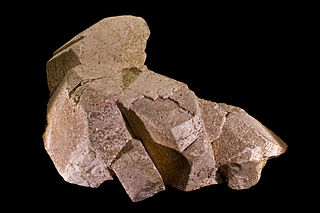
Orthoclase, or orthoclase feldspar (endmember formula KAlSi3O8), is an important tectosilicate mineral which forms igneous rock. The name is from the Ancient Greek for "straight fracture", because its two cleavage planes are at right angles to each other. It is a type of potassium feldspar, also known as K-feldspar. The gem known as moonstone (see below) is largely composed of orthoclase.
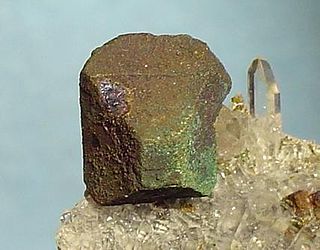
Bornite, also known as peacock ore, is a sulfide mineral with chemical composition Cu5FeS4 that crystallizes in the orthorhombic system (pseudo-cubic).
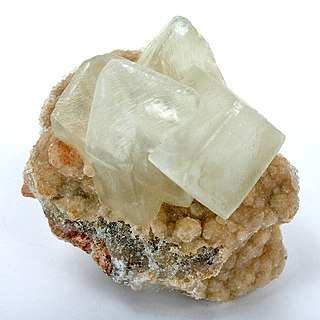
Smithsonite, also known as zinc spar, is the mineral form of zinc carbonate (ZnCO3). Historically, smithsonite was identified with hemimorphite before it was realized that they were two different minerals. The two minerals are very similar in appearance and the term calamine has been used for both, leading to some confusion. The distinct mineral smithsonite was named in 1832 by François Sulpice Beudant in honor of English chemist and mineralogist James Smithson (c. 1765–1829), who first identified the mineral in 1802.
Zirkelite is an oxide mineral with the chemical formula (Ca,Th,Ce)Zr(Ti,Nb)2O7. It occurs as well-formed fine sized isometric crystals. It is a black, brown or yellow mineral with a hardness of 5.5 and a specific gravity of 4.7.

Tephroite is the manganese endmember of the olivine group of nesosilicate minerals with the formula Mn2SiO4. A solid solution series exists between tephroite and its analogues, the group endmembers fayalite and forsterite. Divalent iron or magnesium may readily replace manganese in the olivine crystal structure.
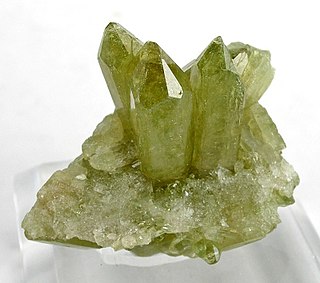
Vesuvianite, also known as idocrase, is a green, brown, yellow, or blue silicate mineral. Vesuvianite occurs as tetragonal crystals in skarn deposits and limestones that have been subjected to contact metamorphism. It was first discovered within included blocks or adjacent to lavas on Mount Vesuvius, hence its name. Attractive-looking crystals are sometimes cut as gemstones. Localities which have yielded fine crystallized specimens include Mount Vesuvius and the Ala Valley near Turin, Piedmont.

Tusionite is a rare colorless to transparent to translucent yellow brown trigonal borate mineral with chemical formula: MnSn(BO3)2. The mineral is composed of 18.86% manganese, 40.76% tin, 7.42% boron, and 32.96% oxygen. It is a late stage hydrothermal mineral and occurs rarely in granite pegmatites in miarolitic cavities.
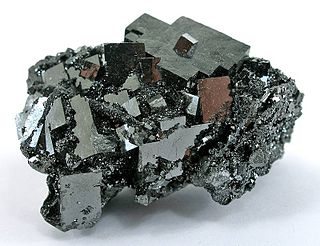
Bixbyite is a manganese iron oxide mineral with chemical formula: (Mn,Fe)2O3. The iron/manganese ratio is quite variable and many specimens have almost no iron. It is a metallic dark black with a Mohs hardness of 6.0 – 6.5. It is a somewhat rare mineral sought after by collectors as it typically forms euhedral isometric crystals exhibiting various cubes, octahedra, and dodecahedra.

Sugilite ( SOO-gə-lyte, -jee-) is a relatively rare pink to purple cyclosilicate mineral with the complex chemical formula KNa2(Fe, Mn, Al)2Li3Si12O30. Sugilite crystallizes in the hexagonal system with prismatic crystals. The crystals are rarely found and the form is usually massive. It has a Mohs hardness of 5.5–6.5 and a specific gravity of 2.75–2.80. It is mostly translucent. Sugilite was first described in 1944 by the Japanese petrologist Ken-ichi Sugi (1901–1948) for an occurrence on Iwagi Islet, Japan, where it is found in an aegirine syenite intrusive stock. It is found in a similar environment at Mont Saint-Hilaire, Quebec, Canada. In the Wessels mine in Northern Cape Province of South Africa, sugilite is mined from a strata-bound manganese deposit. It is also reported from Liguria and Tuscany, Italy; New South Wales, Australia and Madhya Pradesh, India.
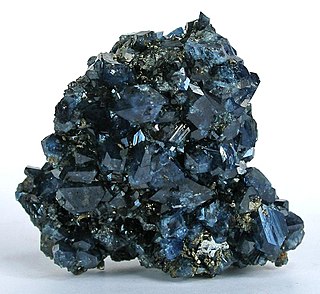
Scorodite is a common hydrated iron arsenate mineral, with the chemical formula FeAsO4·2H2O. It is found in hydrothermal deposits and as a secondary mineral in gossans worldwide. Scorodite weathers to limonite.
Saliotite is a rare colorless to pearl white phyllosilicate mineral in the smectite group with formula (Li,Na)Al3(AlSi3O10)(OH)5. It is an ordered 1:1 interstratification of cookeite and paragonite. It has perfect cleavage, a pearly luster and leaves a white streak. Its crystal structure is monoclinic, and it is a soft mineral with a hardness rated 2-3 on the Mohs scale.

Zirconolite is a mineral, calcium zirconium titanate; formula CaZrTi2O7. Some examples of the mineral may also contain thorium, uranium, cerium, niobium and iron; the presence of thorium or uranium would make the mineral radioactive. It is black or brown in color.

Sabinaite (Na4Zr2TiO4(CO3)4) is a rare carbonate mineral. It crystallizes in the monoclinic crystal system as colorless to white prisms within cavities. It is more typically found as powdery coatings and masses. It has a specific gravity of 3.36.
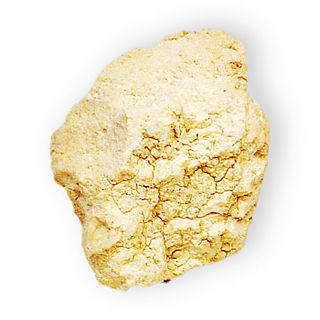
Hectorite is a rare soft, greasy, white clay mineral with a chemical formula of Na0.3(Mg,Li)3Si4O10(OH)2.
Anandite is a rare phyllosilicate with formula (Ba,K)(Fe2+,Mg)3(Si,Al,Fe)4O10(S,OH)2. It crystallizes in the monoclinic crystal system. It is black in color with a glassy luster and a near perfect cleavage.
Brownleeite is a silicide mineral with chemical formula MnSi. It was discovered by researchers of the Johnson Space Center in Houston while analyzing the Pi Puppid particle shower of the comet 26P/Grigg-Skjellerup. The only other known natural manganese silicide is mavlyanovite, Mn5Si3.
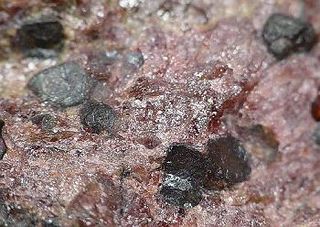
Manganosite is a rare mineral composed of manganese(II) oxide MnO. It was first described in 1817 for an occurrence in the Harz Mountains, Saxony-Anhalt, Germany. It has also been reported from Langban and Nordmark, Sweden and at Franklin Furnace, New Jersey. It also occurs in Japan, Kyrgyzstan and Burkina Faso.
Lithiophosphate is a natural form of (pure) lithium orthophosphate. It is an exceedingly rare mineral, occurring in some special types of pegmatites.
Faizievite is a very rare mineral with the formula K2Na(Ca6Na)Ti4Li6Si24O66F2. This triclinic mineral is chemically related to baratovite and katayamalite. Faizievite is a single-locality mineral, coming from the moraine of the Darai-Pioz glacier, Tien Shan Mountains, Tajikistan. Alkaline rocks of this site are famous for containing numerous rare minerals, often enriched in boron, caesium, lithium, titanium, rare earth elements, barium, and others.
References
- ↑ Warr, L.N. (2021). "IMA–CNMNC approved mineral symbols". Mineralogical Magazine. 85 (3): 291–320. Bibcode:2021MinM...85..291W. doi: 10.1180/mgm.2021.43 . S2CID 235729616.
- ↑ Mineralienatlas
- 1 2 Cabriite Mineral Data from Webmineral
- ↑ Cabriite: Cabriite mineral information and data from Mindat.org